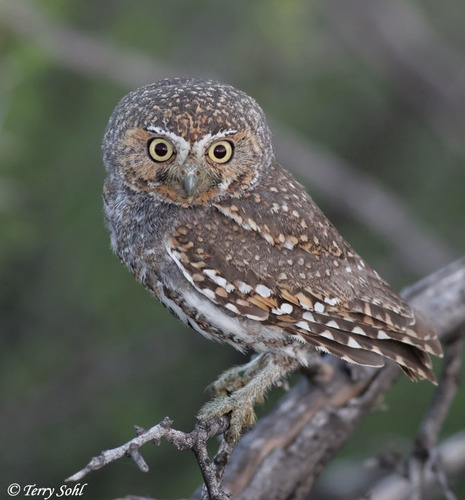
Elf Owl
The Elf Owl (*Micrathene whitneyi*) is one of the smallest owl species in the world, primarily inhabiting the southwestern United States and Mexico. This tiny predator plays a crucial role in its desert and riparian ecosystems by controlling insect and small rodent populations. It is particularly notable for its close association with saguaro cacti, often nesting in cavities excavated by woodpeckers. While not widely recognized in popular culture, the Elf Owl holds a special place in the natural heritage of the arid regions it calls home, symbolizing the delicate balance of life in these harsh environments.
12.5-14.5 cm
Length
25-28 cm
Wingspan
Least Concern
Conservation Status
Distribution
The Elf Owl's range extends from the southwestern United States (southeastern California, southern Arizona, southern New Mexico, and southwestern Texas) south through much of Mexico, including Baja California. They are migratory, with most populations wintering in central and southern Mexico.
Lifespan
3-5 years in the wild; up to 9 years in captivity.
Elf Owl's Habitat
Habitat Types
Desert scrub, Riparian woodlands, Canyonlands, Oak woodlands
Climate Zones
Arid, Semi-arid
Adaptations
Elf Owls are well-adapted to arid environments. Their small size helps them conserve water, and their nocturnal habits allow them to avoid the extreme daytime heat. They frequently utilize pre-existing cavities, often in saguaro cacti or trees, for nesting and roosting, providing shelter from the elements.
Variations
Four subspecies are generally recognized, differing slightly in size and plumage coloration. These variations are often linked to geographic location.
Appearance
Breeding Plumage
No significant difference between breeding and non-breeding plumage.
Seasonal Feather Changes
Minimal seasonal variation.
Sex Based Plumage Differences
Limited sexual dimorphism; males and females have similar plumage, typically mottled grayish-brown with pale underparts and facial disks.
Notable Features
Extremely small size, Short tail, Large, yellow eyes, Lack of ear tufts
Diet and Feeding
Primary Foods
Insects (e.g., moths, beetles, crickets), Arthropods (e.g., scorpions, spiders), Small vertebrates (occasionally)
Foraging Behavior
Elf Owls are primarily nocturnal hunters. They employ a 'sit-and-wait' strategy, perching on branches or cacti and waiting for prey to pass by. They also glean insects from foliage and occasionally catch prey in flight.
Specializations
Their small size and agility allow them to maneuver effectively in dense vegetation while hunting. Their keen eyesight and hearing are adapted for locating prey in low-light conditions.
Seasonal Diet Variations
Diet may shift slightly depending on prey availability. During the breeding season, insects are the primary food source. In winter, they may rely more on arthropods.
Behavior
Social Structure
Generally solitary or found in pairs during the breeding season. Outside of breeding, they may form small, loose flocks during migration.
Communication
High-pitched calls and whistles, Chattering sounds, Soft hoots
Migration
Most Elf Owl populations are migratory, traveling south to Mexico for the winter. The timing and distance of migration vary depending on the location of the breeding population.
Territorial or Group Behaviors
They defend small territories around their nest sites during the breeding season. They are known to feign death when threatened, a behavior called thanatosis.
Conservation
Threats
Habitat loss (due to urbanization, agriculture, and saguaro cactus decline), Pesticide use (reducing insect prey), Climate change (potentially affecting prey availability and nesting success)
Protection Programs
Monitoring of populations, Habitat preservation efforts (especially saguaro cactus conservation)
Local National Laws
Protected under the Migratory Bird Treaty Act in the United States.
Population Trend
Stable
Population Estimates
Difficult to estimate precisely due to their small size and nocturnal habits, but considered relatively common within their range.
Interesting Facts
Elf Owls are among the smallest owls in the world.
Their diminutive size allows them to exploit a unique niche in their ecosystem.
They often nest in saguaro cacti.
This provides them with a safe and well-insulated nesting site.
Elf Owls are known to play dead when threatened.
This is a defense mechanism known as thanatosis and is used by some species to avoid danger.
Faqs about Elf Owl
What do Elf Owls eat?
Elf Owls primarily eat insects, such as moths, beetles, and crickets. They also eat scorpions and occasionally small vertebrates.
Where do Elf Owls live?
Elf Owls live in the southwestern United States and Mexico, typically in desert scrub, riparian woodlands, and areas with saguaro cacti.
Are Elf Owls endangered?
Elf Owls are currently listed as Least Concern by the IUCN, meaning they are not considered to be at immediate risk of extinction. However, habitat loss and pesticide use are potential threats.
Copyright @ Nature Style Limited. All Rights Reserved.
 English
English